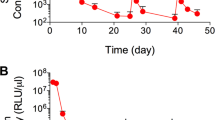Abstract
Cytomegalovirus (CMV) immediate early promoter is a powerful promoter frequently used for driving the expression of transgenes in mammalian cells. However, this promoter gradually becomes silenced in stably transfected cells. We employed Chinese Hamster Ovary (CHO) and human pancreatic cancer (Panc 1) cells stably tansfected with three glycogenes driven by a CMV promoter to study the activation of silenced glycogenes. We found that butyrate, tricostatin A (TSA), and 5-aza-2′-deoxycytidine (5-Aza-dC) can activate these CMV-driven glycogenes. The increase in mRNA and protein of a glycogene occurred 8–10 h after butyrate treatment, suggesting an indirect effect of butyrate in the activation of the transgene. The enhanced expression of the trangenes by butyrate and TSA, known inhibitors of histone deacetylase, was independent of the transgene or cell type. However, the transgene can be activated by these two agents in only a fraction of the cells derived from a single clone, suggesting that inactivation of histone deacetylase can only partially explain silencing of the transgenes. Combination treatment of one or both agents with 5-Aza-dC, a known inhibitor of DNA methylase, resulted in a synergistic activation of the transgene, suggesting a cross-talk between histone acetylation and DNA demethylation. Understanding the mechanisms of the inactivation and reactivation of CMV promoter-controlled transgenes should help develop an effective strategy to fully activate the CMV promoter-controlled therapeutic genes silenced by the host cells. Published in 2005.
Similar content being viewed by others
References
Knust B, Bruggemann U, Doerfler W, Reactivation of a methylation-silenced gene in adenovirus-transformed cells by 5-azacytidine or by E1A trans activation, J Virol 63, 3519–24 (1989).
Verma IM, Somia N, Gene therapy—promises, problems and prospects, Nature 389, 239–42 (1997).
Palmer TD, Rosman GJ, Osborne WR, Miller AD, Genetically modified skin fibroblasts persist long after transplantation but gradually inactivate introduced genes, Proc Natl Acad Sci USA 88, 1330–4 (1991).
Swindle CS, Klug CA, Mechanisms that regulate silencing of gene expression from retroviral vectors, J Hematother Stem Cell Res 11, 449–56 (2002).
Palermo DP, DeGraaf ME, Marotti KR, Rehberg E, Post LE, Production of analytical quantities of recombinant proteins in Chinese hamster ovary cells using sodium butyrate to elevate gene expression, J Biotechnol 19, 35–47 (1991).
Chen WY, Bailey EC, McCune SL, Dong JY, Townes TM, Reactivation of silenced, virally transduced genes by inhibitors of histone deacetylase, Proc Natl Acad Sci USA 94, 5798–803 (1997).
Chen WY, Townes TM, Molecular mechanism for silencing virally transduced genes involves histone deacetylation and chromatin condensation, Proc Natl Acad Sci USA 97, 377–82 (2000).
Cameron EE, Bachman KE, Myohanen S, Herman JG, Baylin SB, Synergy of demethylation and histone deacetylase inhibition in the re-expression of genes silenced in cancer, Nat Genet 21, 103–7 (1999).
Szyf M, Kaplan F, Mann V, Giloh H, Kedar E, Razin A, Cell cycle-dependent regulation of eukaryotic DNA methylase level, J Biol Chem 260, 8653–6 (1985).
Cervoni N, Szyf M, Demethylase activity is directed by histone acetylation, J Biol Chem 276, 40778–87 (2001).
Cervoni N, Detich N, Seo SB, Chakravarti D, Szyf M, The oncoprotein Set/TAF-1beta, an inhibitor of histone acetyltransferase, inhibits active demethylation of DNA, integrating DNA methylation and transcriptional silencing, J Biol Chem 277, 25026–31 (2002).
Li CM, Joshee N, Adler KB, Cheng PW, Development of monoclonal antibodies against bovine mucin core 2 β6 N-acetyl glucosaminyltransferase, Glycoconjugate J 16, 555–62 (1999).
Choi KH, Osorio FA, Cheng P-W, Mucin biosynthesis-Bovine C2GnT-M gene, tissue-specific expression, and Herpes virus-4 homologue, Am J Respir Cell Mol Biol 30, 710–9 (2004).
Beum P, Singh J, Burdick M, Hollingsworth M, Cheng P-W, Generation of sialyl Lewis x by transfection of human pancreatic adenocarcinoma cells with core 2 glycosyltransferase cDNA, J Biol Chem 274, 24641–8 (1999).
Cheng PW, Receptor ligand-facilitated gene transfer: Enhancement of liposome-mediated gene transfer and expression by transferrin, Hum Gene Ther 7, 275–82 (1996).
Burdick MD, Harris A, Reid CJ, Iwamura T, Hollingsworth MA, Oligosaccharides expressed on MUC1 produced by pancreatic and colon tumor cell lines, J Biol Chem 272, 24198–202 (1997).
Cheng PW, Wingert WE, Little MR, Wei R, Mucin biosynthesis. Properties of a bovine tracheal mucin beta-6-N-acetylglucosaminyltransferase, Biochem J 227, 405–12 (1985).
Yanagihara K, Cheng H, Cheng P-W, Effects of epidermal growth factor, transferrin, and insulin on lipofection efficiency in human lung carcinoma cells, Cancer Gene Ther 7, 59–65 (2000).
Datti, A, Dennis, JW, Regulation of UDP-GlcNAc:Gal β 1-3GalNAc-R β 1-6-N-acetylglucosaminyltransferase (GlcNAc to GalNAc) in Chinese hamster ovary cells, J Biol Chem 268, 5409–16 (1993).
Singh J, Khan GA, Kinarsky L, Cheng H, Wilken J, Choi KH, Bedows E, Sherman S, Cheng P-W, Identification of disulfide bonds among the nine core 2 N-acetylglucosaminyltransferase-M cysteines conserved in the mucin β 6 N-acetylglucosaminyltransferase family, J Biol Chem 279, 38969–77 (2004).
Davie JK, Dent SY, Histone modifications in corepressor functions, Curr Top Dev Biol 59, 145–63 (2004).
Luo RX, Postigo AA, Dean DC, Rb interacts with histone deacetylase to repress transcription, Cell 92, 463–73 (1998).
Magnaghi-Jaulin L, Groisman R, Naguibneva I, Robin P, Lorain S, Le Villain JP, Troalen F, Trouche D, Harel-Bellan A, Retinoblastoma protein represses transcription by recruiting a histone deacetylase, Nature 391, 601–5 (1998).
Matzke MA, Mette MF, Matzke AJ, Transgene silencing by the host genome defense: Implications for the evolution of epigenetic control mechanisms in plants and vertebrates, Plant Mol Biol 43, 401–15 (2000).
Grassi G, Maccaroni P, Meyer R, Kaiser H, D’Ambrosio E, Pascale E, Grassi M, Kuhn A, Di’Nardo P, Kandolf R, Kupper J-H, Inhibitors of DNA methylation and histone deacetylation activate cytomegalovirus promoter-controlled reporter gene expression in human glioblastoma cell line U87, Carcinogenesis 24, 1625–35 (2003).
Author information
Authors and Affiliations
Corresponding author
Rights and permissions
About this article
Cite this article
Choi, K.H., Basma, H., Singh, J. et al. Activation of CMV promoter-controlled glycosyltransferase and β -galactosidase glycogenes by butyrate, tricostatin A, and 5-Aza-2′-deoxycytidine. Glycoconj J 22, 63–69 (2005). https://doi.org/10.1007/s10719-005-0326-1
Received:
Revised:
Accepted:
Issue Date:
DOI: https://doi.org/10.1007/s10719-005-0326-1




